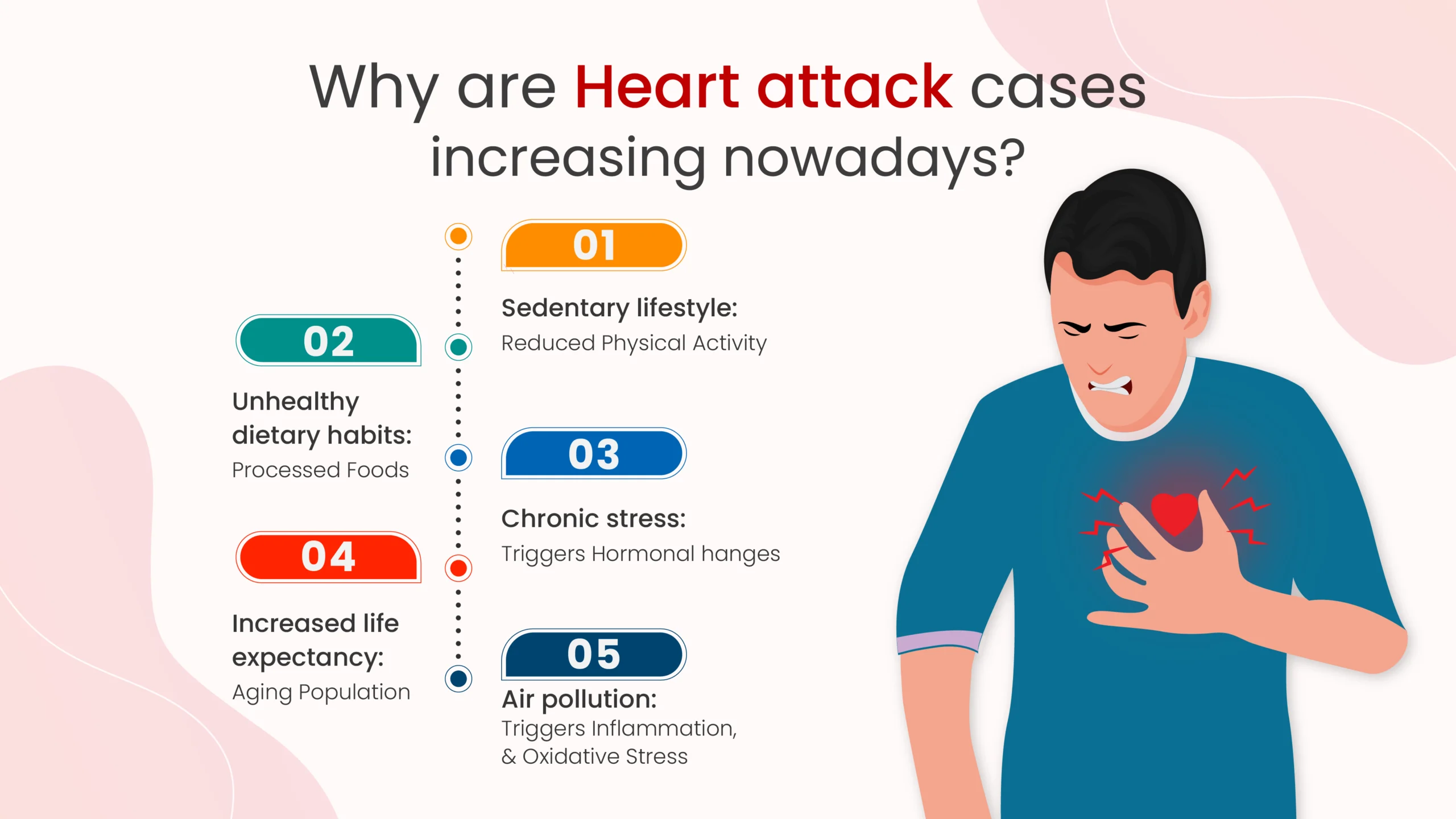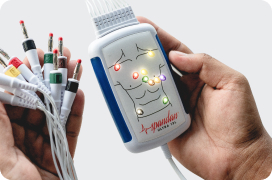
Author:- Mr. Ritesh Sharma
In the last few years, there has been an exponential surge in heart attack cases. People have always been affected by heart diseases and many of them encounter a heart attack. However, it was mostly the old people who faced this problem back in the day. Conversely, nowadays, heart attack cases have been significantly increasing in young adults who used to steer clear of them. Since the epidemic of heart attack cases has arisen, it posits many questions.
Why are heart attack cases increasing nowadays? Why are young people not immune to heart diseases? How can we prevent this epidemic of heart attack cases that has been plaguing the entire world? While there seems to be no easy answer to all these questions, we can try providing you some insights into all of these questions so that you come to terms with the fact that what has been causing the sudden increase in the number of heart attack cases lately.
Furthermore, we will also delve into the preventive measures to steer away from the epidemic of heart attack cases, so that you can incorporate them into your daily routine promptly. Hence, if you have been wondering why are heart attack cases increasing nowadays, you will get some worthy education through this blog.
Causes for Heart Attack Cases Increase
There are several causes of heart attack cases increase. These causes range from lifestyle activities to environmental influences to healthcare dynamics to behavioral risk factors and socioeconomic factors. We will discuss all the causes for the sudden surge in the cases of heart attacks in detail now.
Lifestyle Changes
- Sedentary Lifestyle: Modern life is characterized by reduced physical activity. Technological advancements have made life more convenient, but also more sedentary. Many jobs now require prolonged sitting, and recreational activities often involve screens rather than physical exertion. This lack of movement can lead to obesity, high blood pressure, and high cholesterol levels which can cause problems like heart palpitations and cardiac arrhythmias, all of which are significant risk factors for heart attacks.
- Dietary Habits: The shift towards processed and fast foods has been detrimental to heart health. Diets high in saturated fats, trans fats, sugar, and salt contribute to the development of atherosclerosis (the buildup of plaque in the arteries) and hypertension. These dietary patterns are common in many countries, leading to an increased prevalence of heart disease.
- Stress: Chronic stress, whether from work, financial issues, or personal relationships, has a profound impact on heart health. Stress triggers the release of cortisol and adrenaline, hormones that, in excessive amounts, can damage the cardiovascular system. Furthermore, stress often leads to unhealthy coping mechanisms such as smoking, excessive alcohol consumption, and overeating.
Environmental Influences
- Pollution: Air pollution is a significant yet often overlooked factor in cardiovascular health. Fine particulate matter (PM2.5) from vehicle emissions, industrial processes, and other sources can penetrate deep into the lungs and enter the bloodstream. This pollution triggers inflammation and oxidative stress, which can lead to heart attacks.
- Climate Change: Extreme temperatures, both hot and cold, have been linked to increased heart attack rates. Heatwaves can cause dehydration, and heatstroke, and exacerbate existing cardiovascular conditions. Cold weather, on the other hand, can increase blood pressure and the risk of clotting, leading to a higher incidence of heart attacks.
Healthcare Dynamics
- Increased Life Expectancy: Advances in medical science have increased life expectancy, meaning more people are living longer and thus are at risk of developing age-related conditions, including heart disease. The aging population is a significant factor in the rising number of heart attack cases.
- Better Diagnosis and Reporting: Improvements in healthcare infrastructure and diagnostic techniques mean that heart attacks are more likely to be detected and reported than in the past. While this contributes to the perceived increase in cases, it also reflects the healthcare system’s enhanced capability to identify and treat heart disease.
- Access to Care: Disparities in access to healthcare can exacerbate heart attack rates. In many parts of the world, people lack access to preventive care, early diagnosis, and treatment. This can lead to unmanaged risk factors and higher rates of severe cardiac events.
Behavioral Risk Factors
- Smoking: Despite widespread knowledge of its dangers, smoking remains a leading cause of heart disease. Nicotine and other chemicals in cigarettes damage the cardiovascular system, leading to increased heart attack risk. Although smoking rates have declined in some areas, they remain high in others, contributing to ongoing cardiovascular health issues.
- Alcohol Consumption: Excessive alcohol consumption is another major risk factor. While moderate drinking might have some protective effects, heavy drinking can lead to hypertension, cardiomyopathy, and arrhythmias. These conditions significantly increase the risk of heart attacks.
- Drug Use: The abuse of recreational drugs, such as cocaine and methamphetamines, has cardiovascular implications. These substances can cause acute cardiac events, including heart attacks, by increasing heart rate, blood pressure, and promoting the formation of blood clots.
Socioeconomic Factors
- Economic Stress: Financial instability and economic downturns can lead to increased stress and reduced access to healthy food and healthcare. Economic stress is a significant factor contributing to poor cardiovascular health, as people in lower socioeconomic brackets often have higher rates of smoking, obesity, and hypertension.
- Urbanization: Rapid urbanization has brought about lifestyle changes that negatively impact heart health. Urban environments often promote sedentary lifestyles and provide easy access to unhealthy food options. Additionally, urban stressors, including noise and air pollution, further contribute to cardiovascular risk.
Preventive Measures and Public Health Initiatives
- Education and Awareness: Public health campaigns aimed at educating people about heart disease risk factors are crucial. Increasing awareness about the importance of a healthy diet, regular exercise, and avoiding tobacco and excessive alcohol can help mitigate some of the risk.
- Policy Interventions: Governments and health organizations can implement policies to reduce heart disease risk. These might include regulations on food labeling, restrictions on smoking in public places, and initiatives to reduce air pollution. Policies that promote physical activity, such as creating more parks and pedestrian-friendly infrastructure, are also beneficial.
- Access to Healthcare: Improving access to preventive healthcare services is essential. Regular check-ups, blood pressure monitoring, and cholesterol screening can help identify and manage risk factors early. Ensuring that all population segments have access to these services can reduce heart attack rates.
In conclusion, the increase in heart attack cases is due to all the aforementioned reasons. Not only heart attacks but also conditions such as arrhythmias of different arrhythmia classifications such as monomorphic ventricular tachycardia, wide complex tachycardia, narrow complex tachycardia, etc, can occur due to these factors. Therefore you must keep all the preventive measures in mind and stay vigilant about your heart health. This is the only way to get through this epidemic and emerge victorious.





